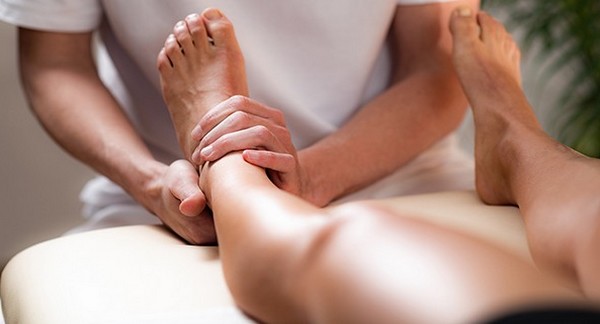Reflexology Near You
Find Reflexology treatments Near You!
Foot reflexology is a holistic therapy deeply rooted in the intricate design of the human foot. It operates on the principle that the foot is a complex network of 15,000 nerve endings, 42 muscles, 33 joints, 26 bones, and over 50 ligaments. Beyond a simple foot rub, foot reflexology, also known as “zone therapy,” works with a map of the foot where each area corresponds to specific organs and glands in the body. This practice extends beyond relaxation, offering a range of physical and emotional benefits.
The Complex Foot Network
The human foot is an intricate structure connecting to our entire body. It's composed of 15,000 nerve endings, 42 muscles, 33 joints, 26 bones, and over 50 ligaments. This complexity is the foundation of foot reflexology, a holistic therapy known for its various benefits. Foot reflexologists use a map of the foot, with each area corresponding to specific organs and glands. The reflexology zones include:
- The Ball of the Foot: Reflects the chest.
- The Ridge Between the Toes and the Ball of the Foot: Corresponds to the shoulder and neck region.
- The Arch: Reflects the digestive organs.
- The Inside Curve of Each Foot: Mirrors the curves of your spine.
- The Toes: Represent the head.
- The Heel and Ankles: Hold reflexes related to the body's reproductive system.
During a foot reflexology session, you'll experience various sensations, from gentle kneading on the ball of the foot to firm tracing around the heel, deep pressure on the arch, and gentle pulling on the toes.

Exploring the Benefits of Foot Reflexology
Foot reflexology offers a spectrum of potential benefits, including:
- Pain Management: Effective in managing pain from arthritis, migraines, and other conditions by targeting reflex points that trigger the body's natural pain-relief mechanisms.
- Stress and Anxiety Reduction: Promotes relaxation and endorphin release, enhancing mood and improving sleep quality.
- Digestive Health: Targets reflex points linked to the digestive system for relief from discomfort and improved digestion.
- Hormonal Balance: Stimulates hormone-related reflex points, aiding women during hormonal fluctuations like menopause.
- Boosts to Immunity: Enhances lymphatic fluid circulation, improving the body's defense against toxins and infections.
- Energy Balancing: Restores energy flow, facilitating the body's healing and repair processes.
- Increase in Healing Enzymes: Stimulates enzyme release, clearing toxins and delivering nutrients to areas needing attention.
Foot reflexology transcends basic massage, targeting specific reflex points. Any discomfort during a session often indicates weaknesses in corresponding body organs. Skilled therapists address these issues using precise techniques, promoting harmony throughout the body.
Distinguishing Foot Reflexology from Traditional Foot Massage
While foot reflexology and traditional foot massage may seem similar, they differ in techniques, focus, and outcomes:
- Foot Reflexology: Uses targeted pressure on reflex points, promoting systemic healing and energy balance.
- Traditional Foot Massage: Focuses on muscle relaxation and improving circulation for general well-being.
Is Reflexology Safe?
Generally safe, reflexology should be approached cautiously by individuals with conditions like pregnancy, foot ulcers, or blood clots. Consulting a healthcare provider is recommended before starting reflexology.
How Much Does Reflexology Cost?
In London and the UK, reflexology at a spa ranges from £40 to £100 or more, depending on the location and spa reputation. High-end spas charge a premium, while boutique options are more affordable.
Freelance mobile therapists typically charge £60 to £90, with potential additional fees for travel. Prices ensure accessibility for diverse budgets, whether at a spa or through mobile services.
In New York, reflexology costs range from $60 to $120, while in Dubai, prices are approximately AED 200 to AED 400, depending on the provider and setting.
Final Note From Massages Me
Explore a diverse array of male massage therapists and female massage therapists offering reflexology and other treatments. Whether you prefer a luxurious spa experience or an in-home service, our platform connects you with skilled professionals who ensure your relaxation and well-being.
Opt for mobile massage therapists for added convenience, bringing the benefits of reflexology directly to your doorstep. From holistic therapies to targeted treatments, Massages Me is your go-to resource for unmatched wellness and rejuvenation.
Related Massage Treatments
Acupressure Acupuncture Aromatherapy Couples Massage Cupping Therapy Deep Tissue Massage Foot Massage Hot Stone Massage Lomilomi Massage Lymphatic Drainage Myofascial Release Pregnancy Massage Reflexology Back Massage Relaxing Massage Shiatsu Massage Swedish Massage Thai Massage Trigger Point Therapy 4 Hands Massage Sports Massage Chinese Massage PhysiotherapyNearby Cities for Reflexology
Panama City, Palikir, Riyadh, Brades, Male, Sao Tome, Rome, Sofia, Khartoum, Nuku`alofa, Bloemfontein, Basse-Terre, Stockholm, Doha, Papeete, Cayenne, Maputo, Paramaribo, Dushanbe, Hanoi, Brussels, Tallinn, Bangkok, Kuala Lumpur, Accra, Malabo, Port Moresby, Charlotte Amalie, Phnom Penh, Lilongwe, Skopje, Grand Turk, Saint John's, Yamoussoukro, Pretoria, Sri Jayewardenepura Kotte, Dakar, Dhaka, Kinshasa, Majuro,Advertise with Massages Me and Grow Your Business!
Create an Ad within minutes & increase your earning potential as we connect you with more clients!